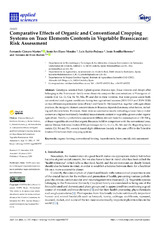Comparative Effects of Organic and Conventional Cropping Systems on Trace Elements Contents in Vegetable Brassicaceae: Risk Assessment
Autor
Cámara Martos, Fernando
Sevillano Morales, Jesús
Rubio-Pedraza, Luis
Bonilla-Herrera, Jesús
Haro Bailón, Antonio de
Editor
MDPIFecha
2021Materia
Organic farmingConventional farming
Trace elements
Heavy metals
Risk assessment
METS:
Mostrar el registro METSPREMIS:
Mostrar el registro PREMISMetadatos
Mostrar el registro completo del ítemResumen
Genotypes selected from 3 plant species (Brassica rapa, Eruca vesicaria and Sinapis alba) belonging to the Brassicaceae family were chosen to compare the concentrations of 9 inorganic elements (Cd, Co, Cr, Cu, Fe, Ni, Mn, Pb and Zn) in these varieties, that were grown under both conventional and organic conditions during two agricultural seasons (2018/2019 and 2019/2020) on two different experimental farms (Farm I and Farm II). We found that, together with agriculture practices, the inorganic element concentrations in Brassicas depended on many other factors, including soil characteristics. However, there were no conclusive results indicating a lower heavy metal content or a higher nutritionally beneficial trace elements content in vegetables grown under organic agriculture. Finally, a probabilistic assessment (@Risk) derived from the consumption of 150–200 g of these vegetables showed that organic Brassicas fulfill in comparison with the conventional ones, similar Dietary Reference Intakes (DRI) percentages for Co, Cr, Cu, Fe, Mn and Zn. Regarding heavy metals (Cd, Ni and Pb), we only found slight differences (mainly in the case of Pb) in the Tolerable Intakes (TI) between both cropping systems.

